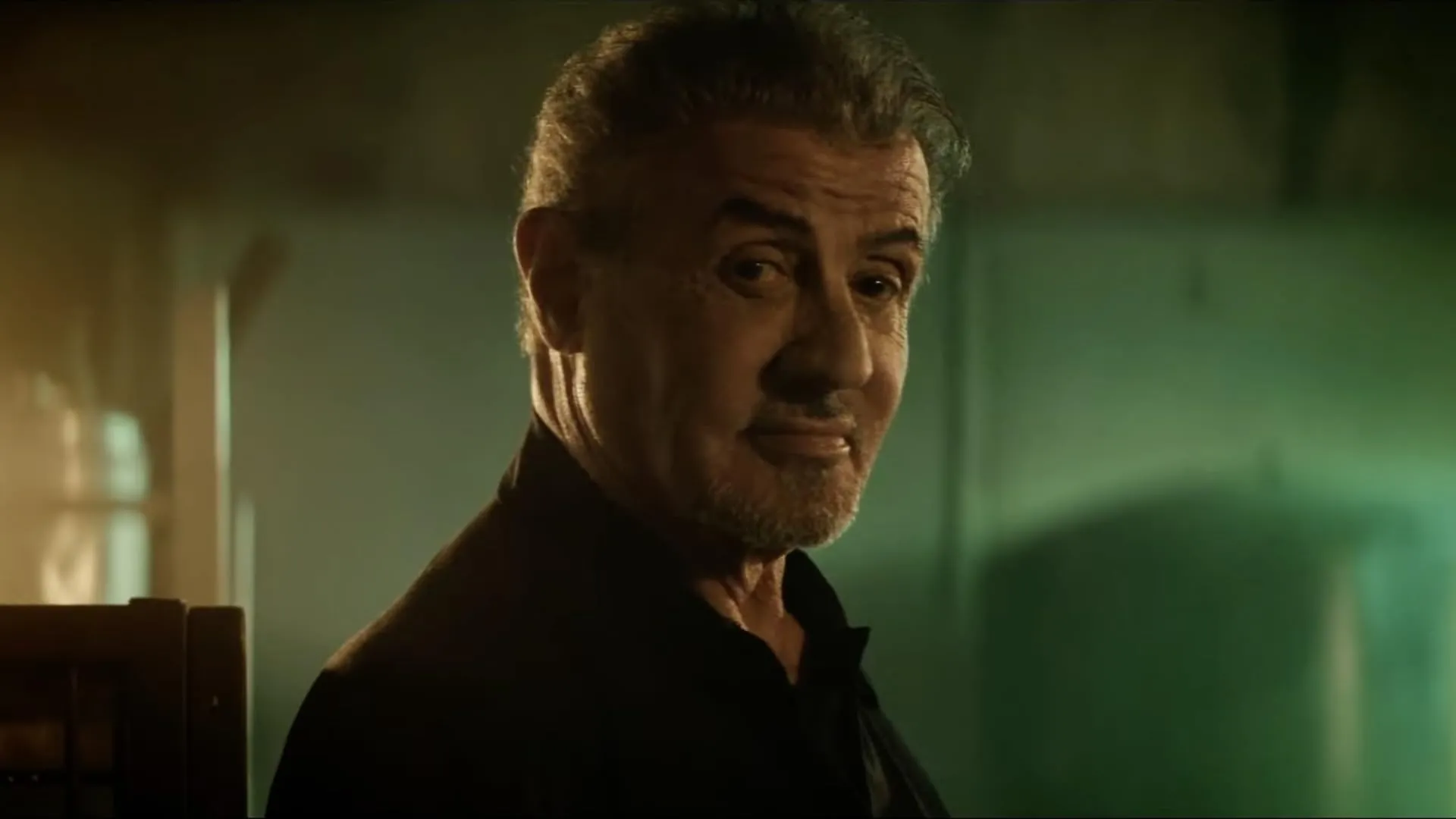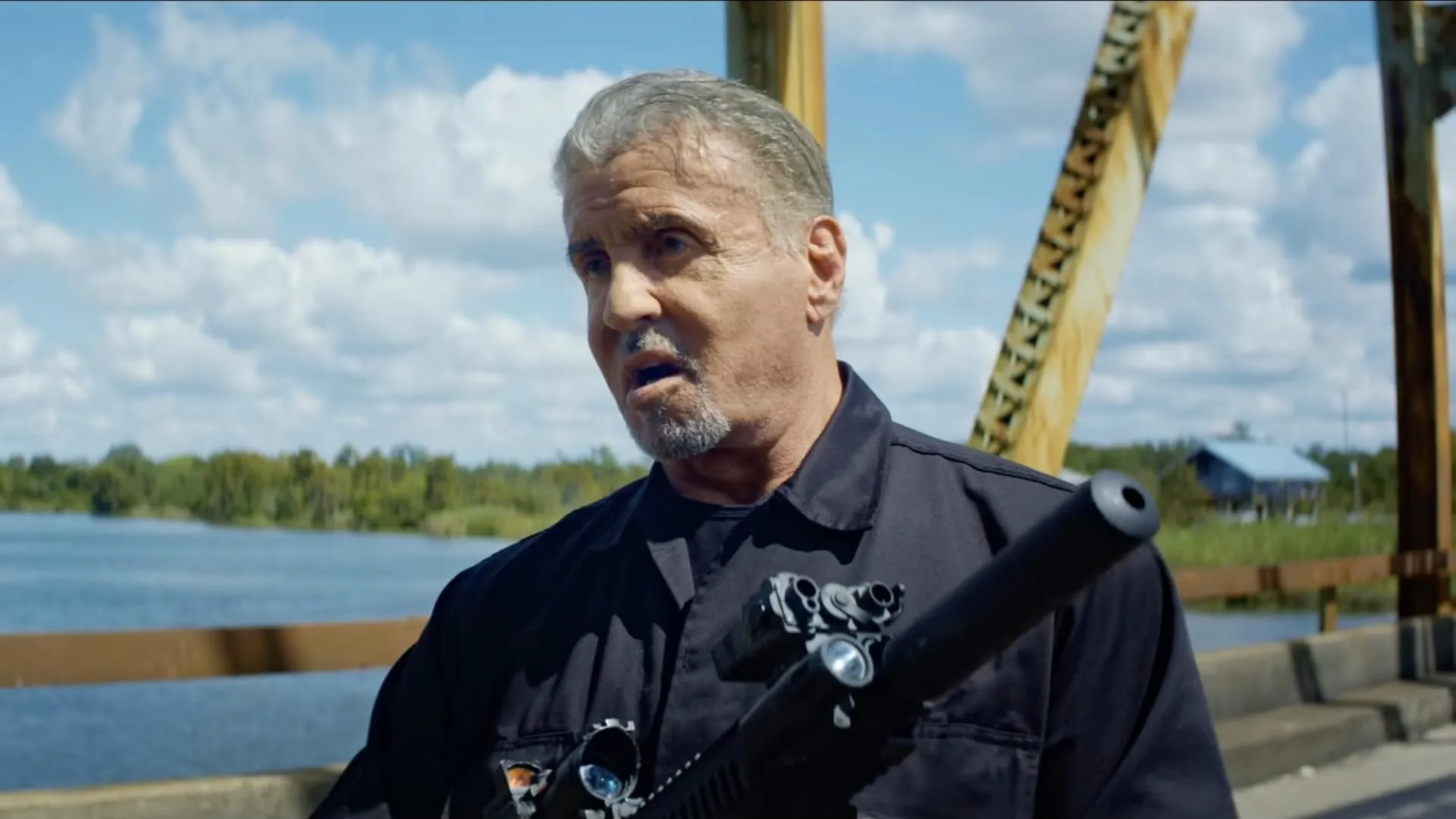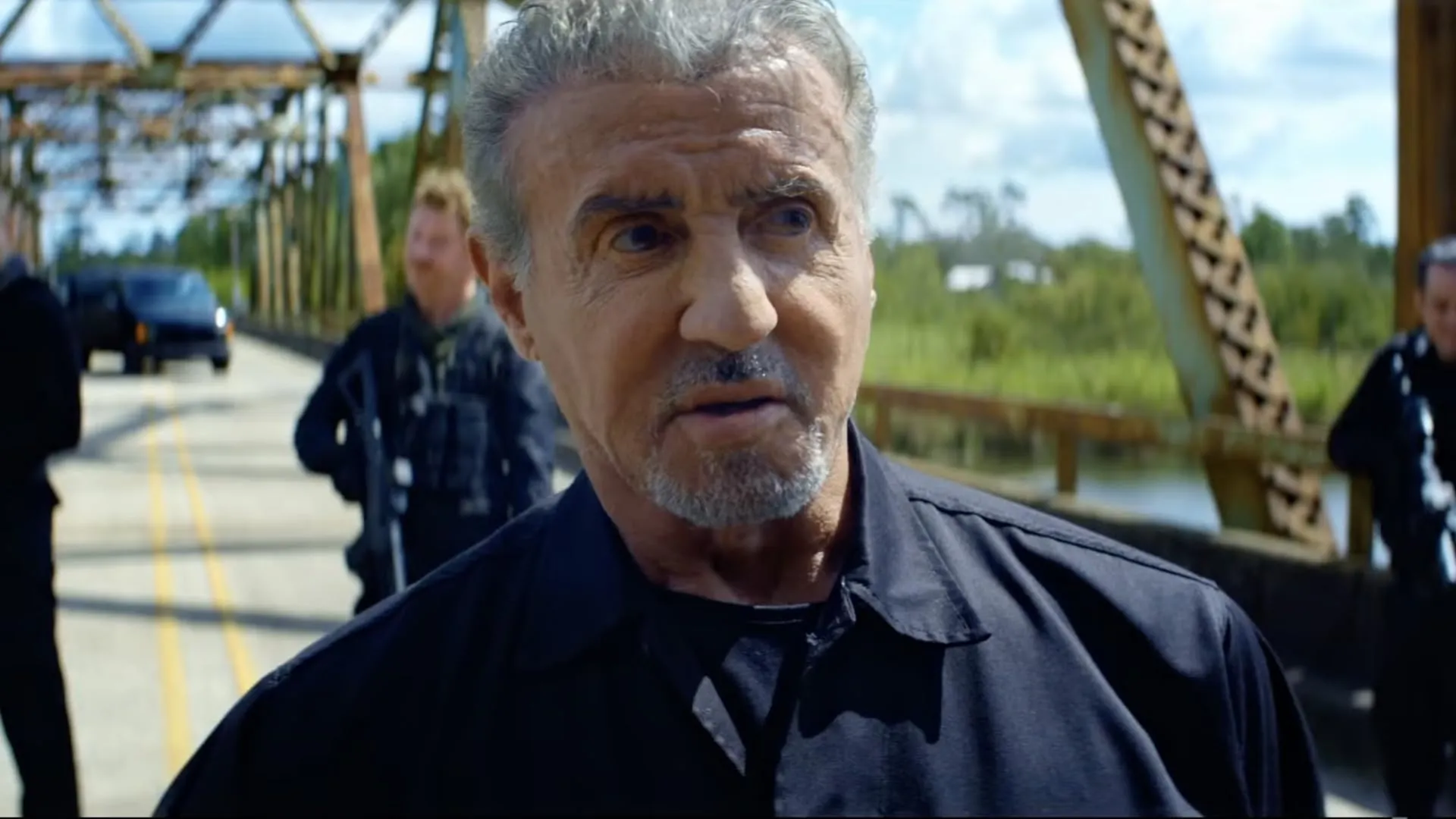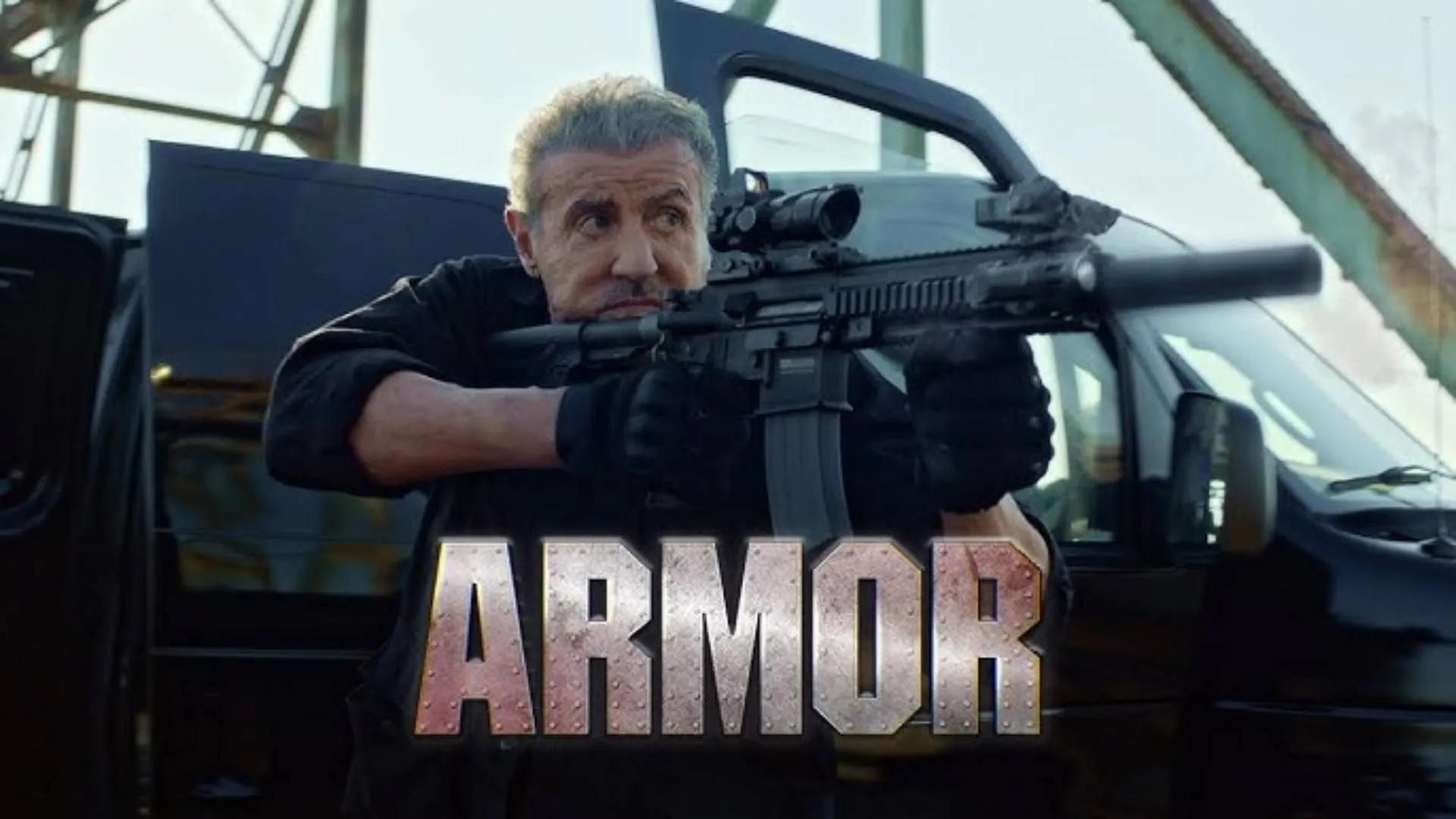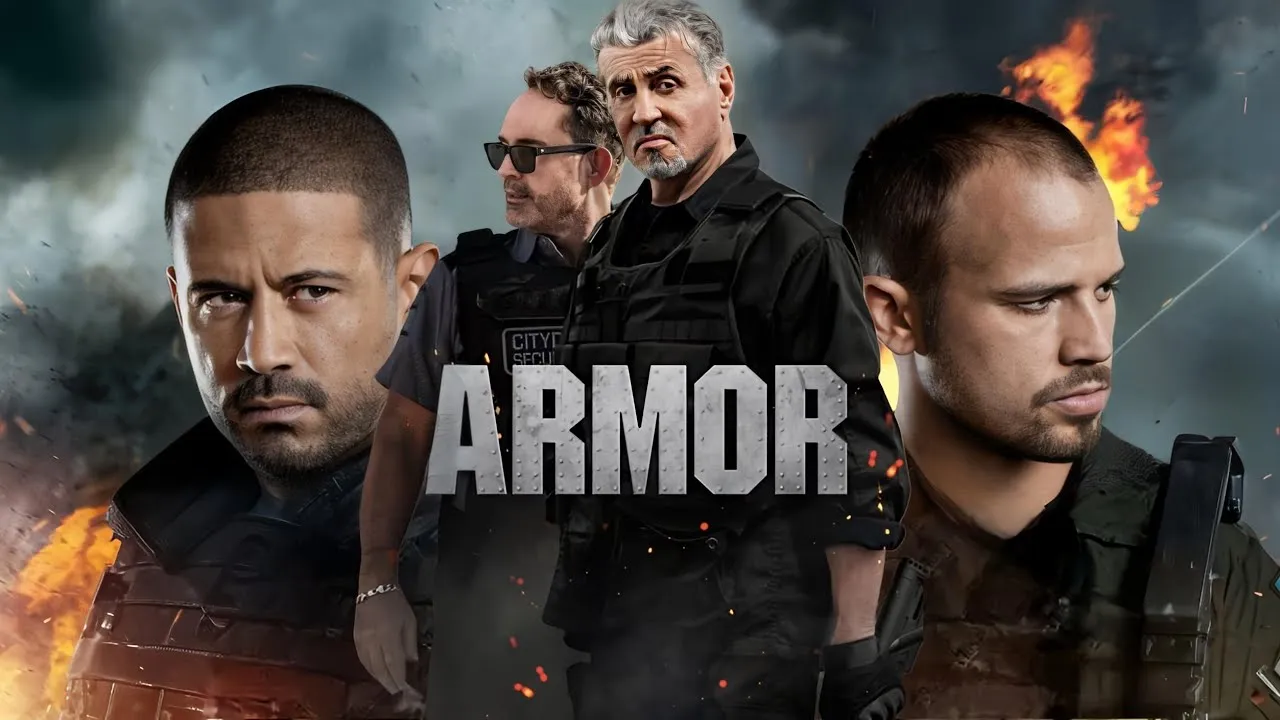Lionsgate’s latest act action-thriller “Armor” rolls into theaters with a storyline that sounds good on paper but fails to deliver high-octane thrills. The film, starring Jason Patric and Josh Wiggins as a father-son armored truck driving tandem, seeks to merge family drama with adrenaline-pumping action, with Sylvester Stallone playing a rare villain role.
The plot revolves around James Brady, a retired cop fighting alcoholism, and his son Casey, who work together to carry precious cargo. Their seemingly regular day takes a disastrous turn when Rook (Stallone) and his gang assault their truck, trapping them on an isolated bridge. What starts as a simple delivery assignment quickly becomes a high-stakes survival scenario in which James must face exterior threats and his inner problems.
At its core, “Armor” is about a shattered father-son relationship set against the backdrop of a botched heist. James, burdened by a sad past that cost him his wife and strained his relationship with Casey, finds himself fighting for survival and redemption. The unmarked case they’re carrying hints there’s more to this job than just transporting cash, adding mystery to the building drama.
Stallone’s role as Rook promises a potentially exciting antagonist, but assessments suggest that his character fails to properly fire the narrative. Instead, the film appears to be more focused on exploring its heroes’ emotional conflicts, potentially at the sacrifice of the action that fans might expect from a thriller of this genre.
With just under 90 minutes, “Armor” aims to build tension through intimate character moments and restrained action. Still, it appears to fall short of providing the explosive pleasure that viewers may expect. The film is another addition to Lionsgate’s growing mixed action portfolio, promising more than it finally delivers.
Behind the Scenes: The Rocky Road of ‘Armor’
The making of “Armor” reads like a Hollywood mystery book, with more narrative twists behind the camera than in front of it. The debate revolves around a questionable directorial credit. Justin Routt’s name may appear in the official credits, but murmurs on set imply a different narrative entirely. According to industry rumors, Randall Emmett may have been the true puppet master, crafting a behind-the-scenes drama that would make “Armor” more compelling than the film itself.
Budget constraints impacted this project more than a sledgehammer. The film’s visual effects appear so cheap that they might make a low-budget sci-fi channel film look like a James Cameron blockbuster. One particularly notorious water scene has been deemed so awful that it could vie for first place in the Worst Special Effects Hall of Fame, with visual ridiculousness on par with “Sharknado” levels.
Sylvester Stallone’s involvement is the most curious production footnote. According to reports, he was on site for only one day and earned $3.5 million for a cameo. The filmmakers appear to have built the entire narrative around his restricted availability, resulting in a villain character who moves in and out of situations like a ghost attempting to evade detection.
The challenges of production were reflected in the finished product. Rook feels more like a cardboard figure than a dynamic enemy, with sequences seemingly patched together to hide his little screen time. The script appears rushed, with story gaps huge enough to drive an armored truck through.
Most damning is the impression of a hasty, fragmented production. Characters make illogical decisions, action sequences lack tension, and the overall narrative feels like a rough script that somehow made it to filming. It’s as if the production team was playing a high-stakes game of moviemaking chicken, hoping that ability and star power would fill the gaps.
Ultimately, “Armor” is a cautionary story about how behind-the-scenes instability may entirely wreck a potentially intriguing concept. What could have been a taut, exhilarating thriller becomes a testament to the problems of low-budget action film creation.
Scripting Struggles: The Narrative Landscape of ‘Armor’
The screenplay for “Armor” feels like a road trip in which the GPS constantly recalculates, never quite reaching its true destination. The script tries to balance family drama and high-stakes action at its foundation, but it often stalls rather than accelerates.
The story’s opening act drags like a broken automobile, spending too much time following James and Casey’s humdrum job routine. The screenplay transforms these moments into a test of viewer patience rather than meaningful exposition, even though character development is important. The father-son dynamic promises depth but delivers predictability rather than actual emotional complexity.
Dialogue has a terrible case of “been there, heard that” syndrome. Characters speak in predictable rhythms, and James’ alcoholism is depicted using eye-rollingly common cliches such as hidden vodka in orange juice cartons and AA meeting scenes that appear to have been taken from a Screenwriting 101 textbook. The talks between characters are rarely more than basic, missing the spark that could enhance the narrative.
Character arcs become a study of wasted possibilities. James, portrayed as a struggling alcoholic ex-cop, hints at potential complexity but is painfully two-dimensional. His redemptive journey feels more like a narrative checkbox than a genuine metamorphosis. Casey is mostly used as a storyline device, with character development sacrificed on the altar of mechanical storytelling.
Despite being played by Sylvester Stallone, the antagonist, Rook, emerges as one of the least developed characters. His objectives are limited to conventional criminal desires, leaving him as memorable as background wallpaper in a drab room.
The screenplay explores atonement, family reconciliation, and survival under pressure. These potentially interesting links, however, become entangled in a narrative that values plot mechanics over true human emotion. Subplots involving James’ past and relationship with Casey feel like forced diversions rather than significant narrative extensions.
Finally, the screenplay for “Armor” is a squandered opportunity. A potentially interesting subject is smothered by formulaic writing and a lack of narrative vision.
Performances Under Pressure: Characters of ‘Armor’
Jason Patric handles “Armor” with the confidence of an experienced actor negotiating dangerous narrative terrain. As James, he creates a character torn between personal redemption and familial survival. His portrayal of an alcoholic father feels both authentic and little caricatured—a man whose internal battles and hidden alcohol stashes become both his vulnerability and potential power.
Patric’s acting shines out as the film’s most subtle element. He transforms James, a potentially one-dimensional struggling father, into a complex character dealing with past pain and present peril. The act of alcoholism is a deeply ingrained character trait that influences every contact and decision.
Josh Wiggins’ Casey serves as an essential counterweight to Patric’s somber intensity. He gives the character a raw, genuine energy, adding much-needed lightness to the film’s otherwise serious tone. While somewhat predictable, Wiggins’ passionate performance and true on-screen chemistry with Patric enhance their father-son connection.
Sylvester Stallone’s Rook is a big squandered opportunity. Despite Stallone’s iconic status in act films, his antagonist feels generic. He’s a bland villain who could have been played by any actor, which is surprising given that he’s known for crafting legendary characters. Rook’s motivations are limited to monetary gain, making him about as fascinating as a cardboard figure holding a gun.
The supporting antagonists, especially Dash Mihok’s Smoke, perform slightly better. Mihok adds a wild energy that temporarily heightens the film’s tension, particularly in the final act. However, these characters are eventually used as cannon fodder rather than significant narrative contributions.
The group performance exposes the screenplay’s underlying flaws. Talented actors like Patric and Wiggins struggle with a storyline that limits their ability to explore their characters’ potential fully. They are instructed to drive a car with an almost empty tank of gasoline.
Finally, “Armor” showcases superb actors desperately attempting to breathe life into a fundamentally poor narrative. The cast is committed, but their efforts cannot fully compensate for the script’s significant flaws.
The performances hint that “Armor” could have been a thrilling, character-driven action thriller rather than the lackluster experience it finally delivers.
Momentum Lost: The Action Landscape of ‘Armor’
“Armor” rolls into theaters promising high-octane excitement but swiftly devolves into a slog that would make even the most patient action enthusiast look at their watch. The film’s action sequences feel more like a rusted armored truck struggling to get pace than a precision-engineered robbery thriller.
The much-anticipated bridge ambush, which should be the film’s highlight, arrives with all the thrill of rush hour traffic. Instead of pulse-pounding tension, viewers are presented with a rather ordinary showdown devoid of the genre’s visceral drive. Action beats are so uncommon and mediocre that they almost appear sorry as if the film is embarrassed by its potential for excitement.
Pacing becomes the principal villain in this case. The first act moves through James and Casey’s everyday routine at the same pace as a paint-drying documentary. Intimate character moments could have been interesting, but they feel like deliberate attempts to stall any major narrative movement. The claimed thriller aspects are so diluted that the phrase “action-thriller” appears more like marketing wishful thinking than a descriptor.
When it comes to genre standards, “Armor” not only falls short but hardly registers on the action movie radar. Whereas films like the John Wick series have transformed action choreography, this film feels like a throwback to a bygone era of straight-to-video mediocrity. The action scenes lack novelty, imagination, and fundamental dynamic energy.
The bridge scenario exemplifies the film’s central problem: potential without execution. What should have been a high-stakes encounter devolved into a meandering exercise in squandered opportunities? Stallone’s presence promises intensity but delivers nothing more than a mediocre performance that could have been lifted from another film entirely.
Ultimately, “Armor” demonstrates that effective action isn’t about explosions or star power but rhythm, tension, and actual stakes. This film lacks all of those, leaving moviegoers weary rather than exhilarated.
Pixels, Sounds, and Shadows: Technical Terrain of ‘Armor’
The technical execution in “Armor” feels like a budget-constrained magic trick in which the magician’s strings are always apparent. Special effects range from barely competent to unintentionally comical, with the infamous water scene as an unexpected highlight of technical incompetence. Imagine an implausible visual effect that would make low-budget YouTube filmmakers cringe; this is the degree of CGI we’re discussing.
The cinematography tries to compensate for budgetary constraints but ultimately fails. The camerawork feels uninspired, capturing action situations with the energy of a surveillance video. The visual aesthetic screams “made-for-streaming” rather than cinematic spectacle, with lighting and frames that speak more to economical restraints than artistic vision.
Sound design is perhaps the most proficient technical part, although this is like being the tallest, short person. Soundtrack selections appear bland, adding more out of necessity than narrative support. Ambient sounds during action sequences lack the precise clarity to heighten tension, instead blurring into an unremarkable sonic landscape.
The water scene is particularly noteworthy, as it is a visual disaster that has the potential to become an internet meme. It’s the type of effect that makes viewers question if the special effects crew used consumer-grade software and weekend instruction.
Technically, “Armor” demonstrates how limiting resources can drastically impair cinematic potential. Every technical element feels like it’s only working half-time, resulting in an irritating rather than entertaining overall experience.
In the world of action cinema, where visual and auditory aspects can transform good stories into legendary experiences, “Armor” feels like a rough manuscript that was mistakenly put into production.
Fractured Bonds: Emotional Terrain of ‘Armor’
The father-son relationship in “Armor” emerges as a potentially interesting narrative thread that hovers on the threshold of substantial development but never quite makes it. James and Casey’s relationship is a perfect example of unresolved tension: a former cop fighting alcoholism and a son dealing with generational failure, stuck together in both actual and metaphorical restricted places.
Their connection aims to go beyond standard action movie familial cliches, hinting at deeper psychological landscapes. James’ issue with alcoholism is more than just a character quirk; it is a fundamental breach in their relationship, resulting in actual vulnerability in moments. However, the screenplay rarely delves fully into these emotional depths, instead treating their connection as a narrative convenience rather than a meaningful emotional anchor.
Themes of atonement run deep beneath the surface, with James seeking personal repair via survival and protection. His character development implies a man urgently wants to reestablish trust and prove his worth as a father. Still, the execution feels more mechanical than truly transformative. The potential for genuine emotional exploration is sometimes sacrificed on the altar of conventional action movie expectations.
Emotional resonance becomes the film’s most important casualty. Moments intended to elicit empathy or tension appear artificial, missing the organic authenticity required to connect with people. James and Casey’s relationship becomes more of a character template than a complex human experience.
“Armor” ultimately reveals itself as a squandered opportunity. This narrative should have been a powerful examination of familial healing, but instead, it becomes just another forgettable act of action. The emotional core is painfully unexplored, leaving viewers intellectually detached rather than emotionally invested.
The Review
Armor
"Armor" is a prime example of squandered potential - a film that promises high-stakes action and emotional depth but delivers nothing more than a formulaic, forgettable film. The film fails to find its foothold with brilliant actors like Jason Patric and Sylvester Stallone forced to navigate a screenplay that feels more like a rough draft than a polished narrative. The core difficulties are great: directorial instability, budget limits, and a script that appears more concerned with ticking genre boxes than creating genuine human drama. Action sequences lack fire, character development feels sluggish, and technical execution is subpar. While glimmers of potential emerge, particularly in Patric's nuanced performance and moments of father-son tension, they are rapidly eclipsed by the film's numerous flaws. "Armor" transforms from an action thriller into a cautionary tale about the perils of hasty production and uninspired storytelling.
PROS
- Jason Patric's nuanced performance as James
- Occasional genuine moments of father-son tension
- Sylvester Stallone's star power (though underutilized)
CONS
- Extremely poor special effects
- Disjointed and slow-paced narrative
- Underdeveloped antagonist characters
- Lack of compelling action sequences
- Budget constraints visibly impacting production quality
- Inconsistent directorial vision









































